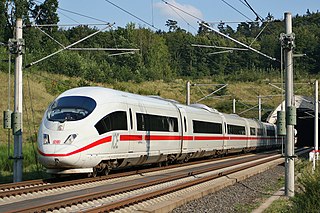
A multiple-unit train is a self-propelled train composed of one or more carriages joined, which if coupled to another multiple unit can be controlled by a single driver, with multiple-unit train control.

A tilting train is a train that has a mechanism enabling increased speed on regular rail tracks. As a train rounds a curve at speed, objects inside the train experience centrifugal force. This can cause packages to slide about or seated passengers to feel squashed by the outboard armrest, and standing passengers to lose their balance. In such excessive speeds, it could even cause the train to derail. Tilting trains are designed to counteract this by tilting the carriages towards the inside of the curve, thus compensating for the g-force. The train may be constructed such that inertial forces cause the tilting, or it may have a computer-controlled powered mechanism.
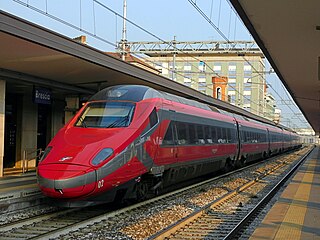
Pendolino is an Italian family of high-speed tilting trains used in Italy, Spain, Germany, Poland, Portugal, Slovenia, Finland, the Czech Republic, Slovakia, the UK, the US, Switzerland, China, and Greece. It was also used in Russia from December 12, 2010 until March 26, 2022. Based on the design of the Italian ETR 401, it was further developed and manufactured by Fiat Ferroviaria, which was taken over by Alstom in 2000.
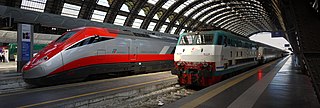
The Italian railway system is one of the most important parts of the infrastructure of Italy, with a total length of 24,567 km (15,265 mi) of which active lines are 16,832 km (10,459 mi). The network has recently grown with the construction of the new high-speed rail network. Italy is a member of the International Union of Railways (UIC). The UIC Country Code for Italy is 83.
Hitachi Rail Italy S.p.A. is a multinational rolling stock manufacturer company based in Pistoia, Italy. Formerly AnsaldoBreda S.p.A., a subsidiary of state-owned Finmeccanica, the company was sold in 2015 to Hitachi Rail of Japan. After the deal was finalized, the current name was adapted in November 2015 to reflect the new ownership.

An electric multiple unit (EMU) is an electric self-powered train, capable of operating in multiple with other EMUs and without the need for a locomotive; these are typically passenger trains with accommodation in every vehicle and a driving position at each end. The term can also be used to describe a train that is a permanent formation with a non-driving power car, such as the Advanced Passenger Train. As of December 2010, two-thirds of the passenger carriages in Great Britain are formed in EMUs.
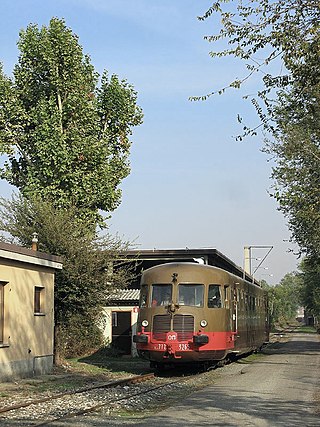
The ALn 772 series are a group of Diesel railcars built for the Italian public railway company Ferrovie dello Stato (FS) between the 1930s and the 1950s. As the first project in Italy to abandon the automobile-derived design and adopt a comprehensive "rolling stock" approach, it represents the link between the simple and sturdy Littorine and the modern Diesel units.

The Italian railway system is one of the most important parts of the infrastructure of Italy, with a total length of 24,227 km (15,054 mi) as of 2011.

The ETR 200 is an Italian electric multiple unit (EMU) introduced in 1936.

The FS E.444 is a class of Italian railways electric locomotives. They were introduced in the course of the 1960s until 1975. Starting from 1989, all E.444s were upgraded as E.444R.

Stadler FLIRT is a passenger multiple unit trainset made by Stadler Rail of Switzerland. The baseline design of FLIRT is an electric multiple unit articulated trainset that can come in units of two to twelve cars with two to six motorized axles. The maximum speed is 200 km/h (125 mph). Standard floor height is 57 cm, but 78 cm high floors are also available for platform heights of 76 cm.

The Trenitalia ETR 700, originally NS Hispeed V250, is a high-speed train designed by Pininfarina and built by AnsaldoBreda originally for NS International and NMBS/SNCB to operate on the Fyra service, a high speed train between Amsterdam and Brussels with a branch to Breda on the newly built HSL-Zuid in the Netherlands and its extension HSL 4 in Belgium.

The ETR 300, also known as "Settebello-type" for its use on the former Settebello train service, is a type of Italian fast electric multiple unit (EMU) trainset formerly operated by Ferrovie dello Stato. The letters ETR stood for elettrotreno rapido. Thanks to its aerodynamically low-drag profile, it boasted a maximum speed of 200 km/h (124 mph), with a power output of 2600 kW. Manufactured for FS by Breda, a total of only three trainsets were built, numbered ETR 301–303.

DBAG Class 411 and Class 415 are German tilting electric multiple-unit high-speed trains in service with DB Fernverkehr, commonly known as ICE T, operationally referred as ICE-T / LPF-T in the timetable documents.
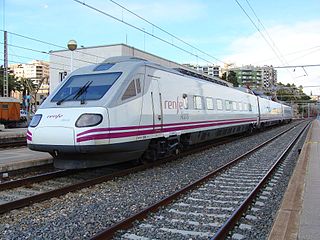
The Renfe Class 490, also known as the ETR 490, is an electric multiple unit constructed by Alstom and Fiat Ferroviaria and operated by Spanish rail company Renfe on its Alaris long-distance services. Since the introduction of the Alaris service, only ETR 490 units have been used for this service. Therefore, these trainsets are often known as Alaris themselves. The units were the first actively tilting units to go into regular service in Spain.

The FS E.326 was a class of Italian railways electric locomotives. Designed in 1929, they were introduced in the early 1930s, for hauling light express passenger trains at high speeds.
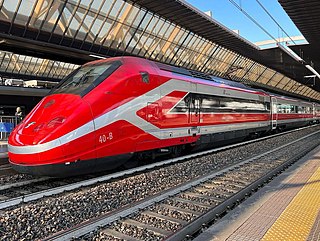
ETR 500 is a family of Italian high-speed trains built by AnsaldoBreda and introduced in 1993.

Metropolitan Railway electric multiple units were used on London's Metropolitan Railway after the lines were electrified in the early 20th century.

The Frecciarossa 1000 is a high-speed train operated by Italian state railway operator Trenitalia and the private Spanish high-speed rail operator Iryo. It was co-developed as a joint venture between Italian rail manufacturer Hitachi Rail Italy and multinational conglomerate Alstom. Both design and production work were divided between the two partner companies.

The Vesuvio was an express train in Italy, linking Milan and Naples. The train was named after Mount Vesuvius the volcano near Naples.

















